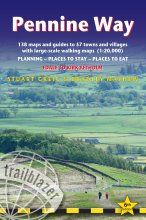Guides that will send you packing.
— Today

Pennine Way: Edale to Kirk Yetholm
Excerpt:
Using this guide
Contents list | Introduction | About the Pennine Way | Practical information for the walker | Itineraries | Using this guide | Sample route guide: Calder Valley to Ickornshaw | GPS waypoints

Using this guide
The trail guide and maps have been divided into 15 stages (walking from south to north, the direction taken by 80% of walkers on the Pennine Way), though these are not to be taken as rigid daily itineraries since people walk at different speeds and have different interests.
The route overviews introduce the trail for each of these stages. They’re followed by navigation notes that will help you identify and overcome potential route-finding trouble-spots. To enable you to plan your itinerary, practical information is presented on the trail maps. This includes walking times for both directions, all places to stay and eat, as well as useful shops and other services. Further details are given in the text under the entry for each place. For an overview of all this information see the town and village facilities table, pp32-5.
TRAIL MAPS
Scale and walking times
The trail maps are to a scale of 1:20,000 (1cm = 200m; 31/8 inches = one mile).
Walking times are given along the side of each map; the arrow shows the direction to which the time refers. The black triangles indicate the points between which the times have been taken. See box below about walking times.
These time-bars are a rough guide and are not there to judge your walking ability; actual walking times will be different for each individual. There are so many variables that affect walking speed from the weather conditions to how many beers you drank the previous evening as well as how much you are carrying. After the first hour or two of walking you’ll be able to see how your speed relates to the timings on the maps.
Up or down?
The trail is shown as a dashed line. An arrow across the trail indicates the slope; two arrows show that it is steep. The arrows always point up hill. If, for example, you are walking from A (at 80m) to B (at 200m) and the trail between the two is short and steep, it would be shown thus: A – – – >>- – – B. Reversed arrow heads indicate a downward gradient.
Accommodation
Apart from in large towns where some selection has been necessary, all accommodation on or close to the trail is marked (or indicated off the maps) with details in the accompanying text. Many B&B proprietors based a mile or two off the trail will, subject to prior arrangement, be happy to collect walkers from the nearest point on the trail and take them back the next morning; a small charge may be payable though.
Details of each place are given in the accompanying text. The number of rooms of each type is given at the beginning of each entry, ie: S = Single, T = Twin room, D = Double room, Tr = Triple room and Qd = Quad. Note that many of the triple/quad rooms have a double bed and one/two single beds (or bunk beds) thus for a group of three or four, two people would have to share the double bed but it also means the room can be used as a double or twin.
Rates quoted for B&B-style accommodation are per person (pp) based on two people sharing a room for a one-night stay; rates are usually discounted for longer stays. Where a single room (sgl) is available the rate for that is quoted if different from the rate per person. The rate for single occupancy (sgl occ) of a double/twin may be higher, and the per person rate for three/four sharing a triple/quad may be lower. At some places the only option is a room rate; this will be the same whether one or two people (or more if permissible) use the room. See box p22 for more information on rates.
The text also mentions whether the bedrooms are en suite, or have private, or shared, facilities (in either case this may be a bathroom or shower room just outside the bedroom). In the text ? signifies that at least one room has a bathroom with a bath, or access to a bath, for those who prefer a relaxed soak at the end of the day.
Also noted is whether the premises have: wi-fi (wi-fi); if dogs (?– see also pp29-30) are welcome, subject to prior arrangement, and any associated charges; and if packed lunches (?) are available (usually these must be requested in advance ie by or on the night before).
Other map features
The numbered GPS waypoints refer to the list on pp277-84. Features are marked on the map when they are pertinent to navigation. In order to avoid cluttering the maps and making them unusable not all features have been marked each time they occur.
Pennine Way: Edale to Kirk Yetholm
Excerpts:
- Contents list
- Introduction
- About the Pennine Way
- Practical information for the walker
- Itineraries
- Using this guide
- Sample route guide: Calder Valley to Ickornshaw
- GPS waypoints
Price: £14.99 buy online now…
Latest tweets